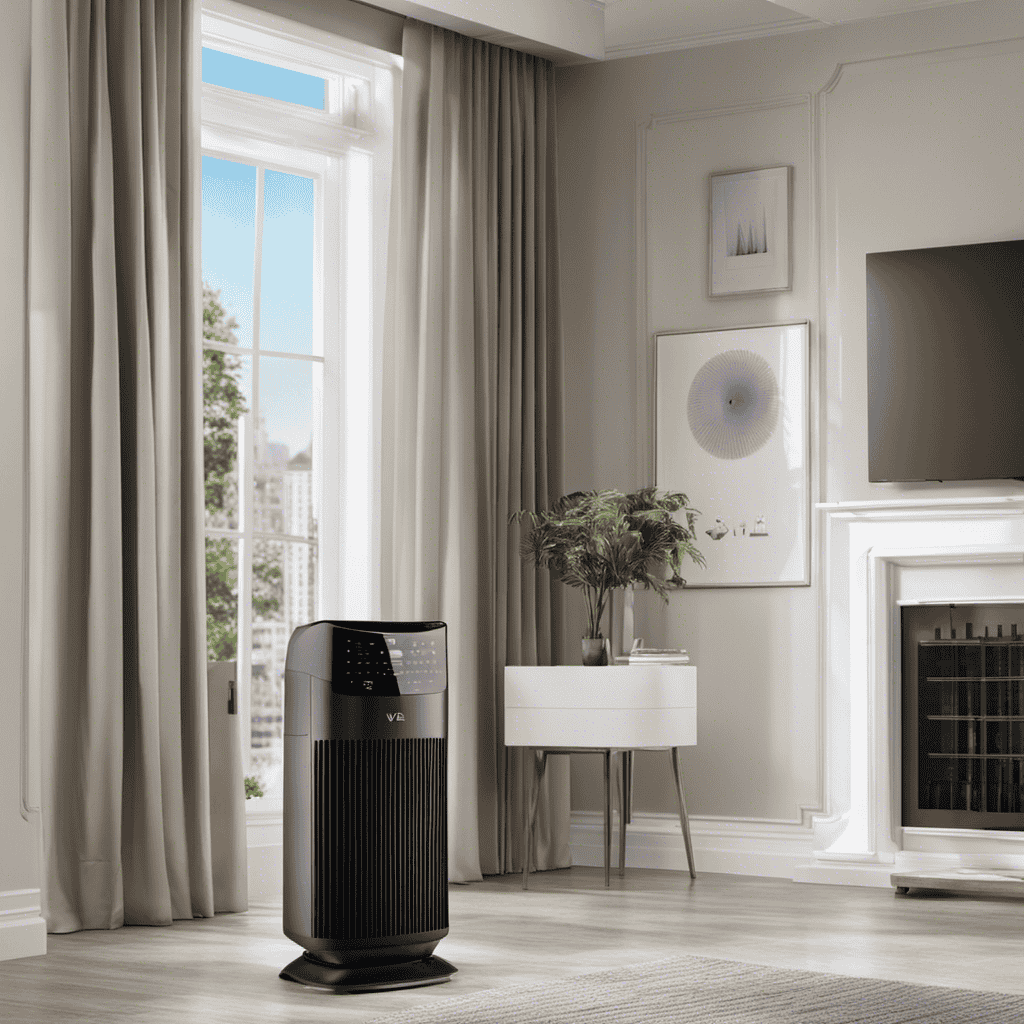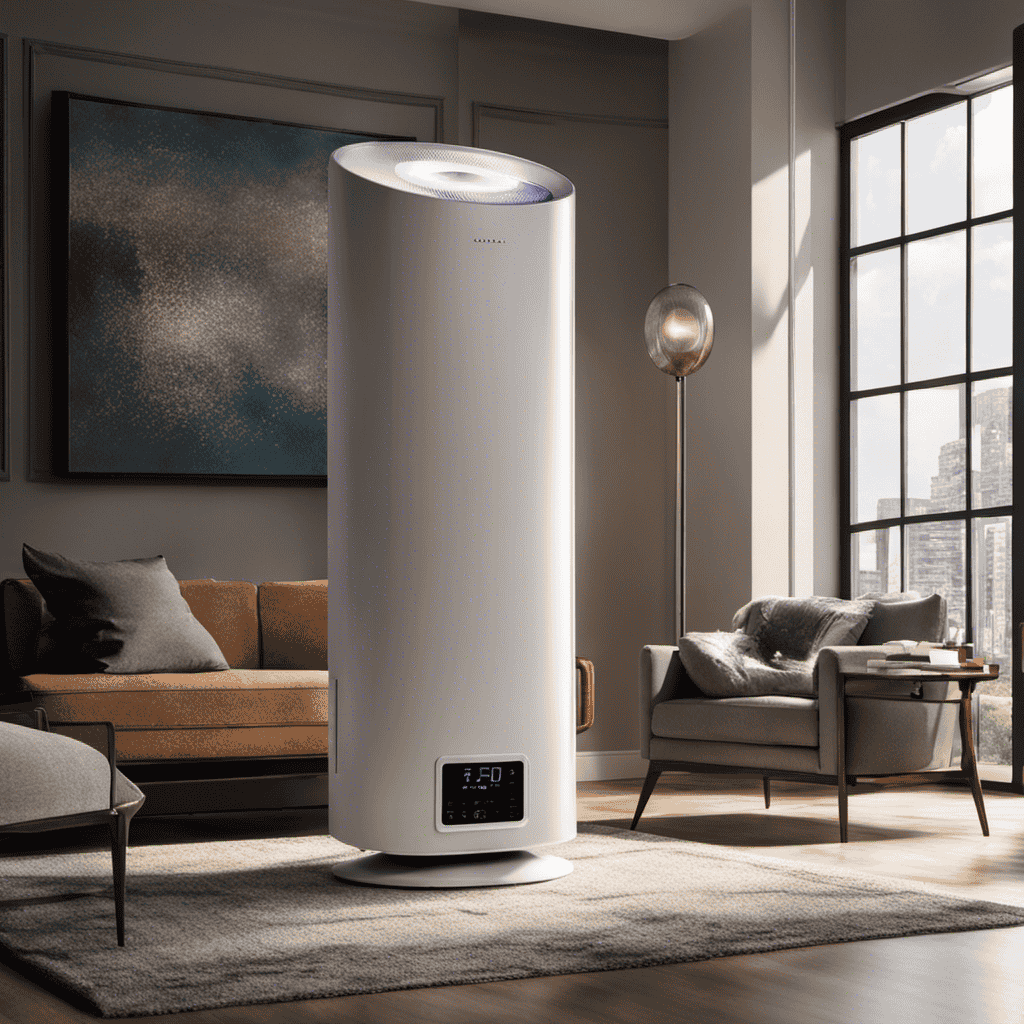They claim that clean air is crucial for a healthy lifestyle, and I couldn’t agree more. That’s why I am here to explain the science behind negative ions in air purifiers.
These tiny particles have been gaining popularity for their ability to improve indoor air quality. In this article, we’ll explore the benefits of negative ions, their role in air purification, and how to choose the right air purifier with this technology.
So sit back, relax, and get ready to breathe in the benefits of negative ions in air purifiers.
Key Takeaways
- Negative ions in air purifiers effectively reduce airborne pollutants like dust, pollen, and pet dander.
- Negative ions in air purifiers have a positive impact on mood, alleviating symptoms of depression, anxiety, and stress.
- Negative ions in air purifiers can provide relief for individuals suffering from allergies and respiratory issues by neutralizing allergens and reducing respiratory symptoms.
- Negative ions in air purifiers improve air quality by attaching to harmful particles in the air, causing them to become heavier and fall to the ground, reducing the risk of respiratory issues like asthma and allergies.
The Science Behind Negative Ions
The science behind negative ions is fascinating and has been studied for years. Negative ions are molecules that have gained an extra electron, making them negatively charged. These ions are naturally present in the environment, especially in places like waterfalls, mountains, and forests.
Research has shown that negative ions play a significant role in our health and well-being. One of the key benefits of negative ions is their effectiveness in relieving stress. Studies have shown that negative ions can help reduce the levels of stress hormones in the body, promoting relaxation and improving mood. They are believed to enhance serotonin production, which is a neurotransmitter responsible for regulating mood, appetite, and sleep.
Understanding the science behind negative ions provides us with valuable insights into the benefits they offer. Now, let’s explore the specific benefits of negative ions in air purifiers.
Benefits of Negative Ions in Air Purifiers
In this discussion, I will explore the benefits of negative ions in air purifiers. I will focus on three key points: improved air quality, mood enhancement effects, and allergy relief potential.
Negative ions have been shown to effectively reduce airborne pollutants. These pollutants include dust, pollen, and pet dander. By reducing these pollutants, negative ions help create a healthier and cleaner indoor environment.
Studies have also suggested that negative ions can have a positive impact on our mood. They can help alleviate symptoms of depression, anxiety, and stress. The mood enhancement effects of negative ions can contribute to an overall sense of well-being and improved mental health.
Furthermore, negative ions may provide relief for individuals suffering from allergies. They can neutralize allergens and reduce respiratory symptoms. This can be especially beneficial for those who experience allergies and respiratory issues in indoor environments.
Improved Air Quality
Breathing clean air is essential, and that’s why an air purifier with negative ions can help improve air quality. Negative ions are beneficial for several reasons:
-
Negative ions attach themselves to harmful particles in the air, such as dust, pollen, and pet dander, causing them to become heavier and fall to the ground.
-
By removing these airborne particles, negative ions reduce the risk of respiratory issues, such as asthma and allergies.
-
Negative ions also help prevent the growth of mold and bacteria, which thrive in damp environments and can cause respiratory infections.
-
Studies have shown that negative ions can enhance the flow of oxygen to the brain, improving concentration, alertness, and overall mental well-being.
-
Negative ions have been found to boost the body’s immune system, allowing it to better fight off infections and diseases.
With these benefits, it’s clear that an air purifier with negative ions is an excellent investment for improving air quality and promoting respiratory health.
Mood Enhancement Effects
Improve your mood with the mood enhancement effects of an air purifier with negative ions. Negative ions are molecules that have gained an electron, resulting in a negative charge. These ions are naturally found in places like waterfalls, forests, and beaches, where the air feels fresher and lighter.
When negative ions are released into the air by an air purifier, they can have a positive impact on mood improvement and mental well-being.
Research has shown that negative ions can increase the levels of serotonin in the brain, which is a neurotransmitter that plays a crucial role in regulating mood. Serotonin is often referred to as the ‘feel-good’ hormone because it helps to promote feelings of happiness and well-being. By increasing serotonin levels, air purifiers with negative ions can help to alleviate symptoms of depression and anxiety, and improve overall mood.
Furthermore, negative ions can also help to reduce stress and fatigue. Studies have found that exposure to negative ions can decrease levels of cortisol, a hormone associated with stress. By reducing cortisol levels, air purifiers with negative ions can help to promote relaxation and improve mental clarity.
Allergy Relief Potential
Allergies can be alleviated with the potential relief offered by an air purifier that utilizes negative ions. Negative ions are electrically charged particles that can help improve indoor air quality by attaching themselves to allergens, such as pollen, dust mites, and pet dander, and causing them to become too heavy to remain airborne. This can significantly reduce the presence of these allergens in the air, minimizing allergic reactions and improving respiratory health.
The benefits of negative ion air purifiers go beyond just allergen removal. Here are five emotional responses you can expect from using a negative ion air purifier:
- Increased sense of calm and relaxation
- Improved mood and overall well-being
- Enhanced mental clarity and focus
- Boosted energy levels
- Reduced stress and anxiety
By harnessing the power of negative ions, these air purifiers create an environment that promotes better respiratory health and provides relief from allergies.
Now, let’s delve into how negative ions improve indoor air quality.
How Negative Ions Improve Indoor Air Quality
You’ll notice a significant difference in the quality of your indoor air once negative ions are introduced into your living space. Negative ions are electrically charged particles that occur naturally in the environment. They can be found in abundance near waterfalls, mountains, and forests. These ions have been proven to have numerous health benefits and can combat pollutants in the air.
Negative ions work by attaching themselves to harmful airborne particles such as dust, pollen, and pet dander. Once attached, these particles become too heavy to remain airborne and eventually fall to the ground or other surfaces. This process effectively reduces the number of pollutants in the air, leading to better indoor air quality.
In addition to reducing airborne pollutants, negative ions have also been shown to improve overall health. They can help alleviate symptoms of allergies, asthma, and respiratory conditions. Negative ions can also boost mood and increase energy levels.
Understanding the Role of Negative Ions in Air Purification
As an air quality expert, I am excited to discuss the benefits of negative ions in air purification. Negative ions are known to improve indoor air quality by neutralizing and removing harmful pollutants such as dust, allergens, and bacteria.
The mechanism behind the air purification capabilities of negative ions involves the attraction and attachment of these pollutants. This allows them to be easily captured and eliminated from the air, resulting in cleaner and healthier indoor environments.
Scientific evidence strongly supports the effectiveness of negative ions in air purification. Numerous studies have shown the positive impact of negative ions on air quality. This provides a solid foundation for their role in effective air purification.
Overall, the benefits of negative ions in air purification, the mechanism behind their air purification capabilities, and the scientific evidence supporting their effectiveness all contribute to their importance in creating cleaner and healthier indoor spaces.
Benefits of Negative Ions
The benefits of negative ions in air purifiers include improved air quality and increased relaxation. Negative ions are tiny particles that have a negative electrical charge. When released into the air, they attach themselves to airborne pollutants, such as dust, pollen, and mold spores, causing them to become heavier and fall to the ground. This process helps to purify the air we breathe, reducing the risk of respiratory problems and allergies.
Additionally, negative ions have been found to have mental health benefits. Research suggests that exposure to negative ions can increase serotonin levels in the brain, promoting feelings of happiness and well-being. Furthermore, negative ion therapy has been shown to reduce stress, improve focus and concentration, and enhance overall mood.
Air Purification Mechanism
When negative ions are emitted, they attach to airborne pollutants and cause them to become heavier, ultimately purifying the air. This air purification mechanism is one of the significant benefits of negative ion generation in air purifiers.
Negative ions, also known as anions, are charged particles that are naturally found in the environment. They are generated in air purifiers through various methods such as corona discharge or ionization. These negative ions attach themselves to airborne particles like dust, pollen, mold spores, and pet dander.
As a result, these pollutants become heavier and fall to the ground or get trapped in the air purifier’s filter, effectively removing them from the air we breathe. This method of air purification is highly effective and has been supported by scientific evidence, which I will discuss in the following section.
Scientific Evidence Supporting Ions
In my research, I have come across numerous scientific studies that support the health benefits of negative ions in air purifiers. These studies have provided compelling evidence that negative ions can have a positive impact on our overall well-being.
Here are some key findings:
-
Improved mood: Negative ions have been shown to increase the levels of serotonin, a neurotransmitter responsible for mood regulation.
-
Reduced stress and anxiety: Research suggests that negative ions can help lower stress and anxiety levels, promoting a sense of calm and relaxation.
-
Enhanced cognitive function: Studies have found that negative ions can improve mental clarity, focus, and alertness.
-
Improved sleep quality: Negative ions have been linked to better sleep by promoting the production of melatonin, a hormone that regulates sleep-wake cycles.
-
Strengthened immune system: Some research suggests that negative ions can boost the immune system, helping the body fight off infections and illnesses.
These scientific findings provide strong support for the inclusion of negative ions in air purifiers for the betterment of our health and well-being.
Negative Ions Vs. Positive Ions: What’s the Difference
Did you know that negative ions and positive ions have distinct differences?
Negative ions are molecules or atoms that have gained an electron, resulting in a negative charge. On the other hand, positive ions have lost an electron, making them positively charged.
These ions play a significant role in various aspects of our health, including mental well-being and immune system function.
Studies have shown that negative ions have a positive impact on mental health. They have been found to reduce symptoms of depression, anxiety, and stress. Negative ions stimulate the production of serotonin, a neurotransmitter that promotes feelings of happiness and relaxation.
Additionally, negative ions can boost our immune system. They have been found to increase the activity of white blood cells, which are responsible for fighting off harmful pathogens and infections. This can lead to a strengthened immune response and improved overall health.
Understanding the differences between negative and positive ions is crucial in harnessing their potential benefits for our well-being. By increasing the presence of negative ions in our environment, whether through air purifiers or natural sources like waterfalls and forests, we can enhance both our mental health and immune system function.
The Mechanism of Negative Ion Generation in Air Purifiers
You can understand how air purifiers generate negative ions by learning about the mechanism behind it. Negative ion formation in air purifiers typically occurs through a process called corona discharge. Here’s a breakdown of how it works:
-
High voltage is applied to a metal needle or wire inside the air purifier.
-
The high voltage creates an electric field around the needle.
-
This electric field causes molecules in the air, such as oxygen and nitrogen, to lose electrons and form negative ions.
-
These negative ions are then emitted into the air, where they can attach to airborne pollutants like dust, pollen, and pet dander.
-
Once attached, the negative ions neutralize the pollutants by binding to their positively charged particles, rendering them harmless.
Understanding this mechanism can help you appreciate the effectiveness of air purifiers in improving indoor air quality by reducing pollutants through negative ion emission.
Common Misconceptions About Negative Ions in Air Purifiers
Now that we understand how negative ions are generated in air purifiers, let’s address some common misconceptions about their effectiveness and potential dangers.
One of the biggest misconceptions is that negative ions alone can completely purify the air in a room. While negative ions do have the ability to attract and neutralize some airborne pollutants, they are not a standalone solution for air purification.
Another misconception is that negative ions are harmful to our health. However, numerous scientific studies have shown that negative ions at typical concentrations found in indoor environments are safe for human exposure.
It is important to note that while negative ions can provide some benefits, they should be used in conjunction with other air purification technologies for optimal results.
Understanding these misconceptions can help us make informed decisions when it comes to choosing the right air purifier for our needs.
Choosing the Right Air Purifier With Negative Ion Technology
When selecting an air purifier with negative ion technology, it’s important to consider the size of the room and the specific pollutants you want to target. Negative ions have been found to have various benefits for air quality, including reducing airborne particles and neutralizing harmful substances.
Here are five reasons why choosing an air purifier with negative ion technology can make a difference:
- Improved mood and reduced stress levels
- Enhanced sleep quality and relaxation
- Increased mental clarity and focus
- Reduced respiratory problems and allergies
- Elimination of unpleasant odors
Understanding negative ion technology is crucial for effective air purifier maintenance. Negative ions attach to pollutants, causing them to become heavy and fall to the ground. Regularly cleaning the purifier and replacing filters is essential to maintain its effectiveness.
Tips for Maximizing the Effectiveness of Negative Ions in Air Purifiers
To maximize the effectiveness of negative ions in your air purifier, it’s essential to regularly clean and replace the filters. These filters play a crucial role in capturing pollutants and allergens, allowing the negative ion technology to work at its highest potential. Neglecting proper maintenance can lead to decreased ion output and reduced air purification efficiency.
To help you understand the importance of proper maintenance, here is a table showcasing the impact of dirty filters on ion output:
| Stage of Filter Clogging | Ion Output (percentage) |
|---|---|
| Clean Filter | 100% |
| Lightly Dirty Filter | 80% |
| Moderately Dirty Filter | 60% |
| Heavily Dirty Filter | 40% |
As you can see, the more clogged the filters become, the lower the ion output. Regularly cleaning or replacing the filters ensures optimal airflow and maximum ion production, allowing your air purifier to effectively eliminate airborne pollutants and improve indoor air quality. Don’t underestimate the power of proper maintenance in maximizing the benefits of negative ion technology.
What are the Benefits of Negative Ion Air Purification?
The buick ionizing air purifier boasts a range of benefits. By releasing negative ions into the air, it can effectively neutralize harmful particles such as dust, pollen, and pet dander. This not only improves air quality but can also help alleviate symptoms of allergies and asthma, promoting overall wellness.
Conclusion
In conclusion, after delving into the science and benefits of negative ions in air purifiers, it is evident that they play a crucial role in improving indoor air quality.
By attracting and neutralizing harmful contaminants, negative ions effectively purify the air we breathe.
While misconceptions exist, understanding the difference between negative and positive ions is essential.
Choosing the right air purifier with negative ion technology and implementing tips for maximum effectiveness is key.
So, why wait? Experience the power of negative ions and breathe in cleaner, fresher air today.










